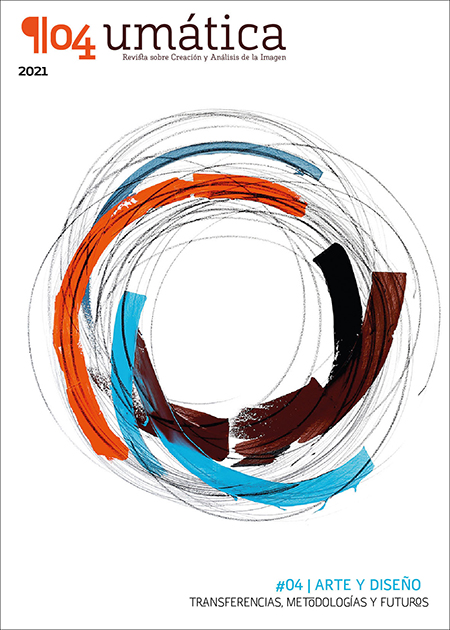¿Qué es una imagen menor? Apuntes sobre las posibilidades políticas de la autorrepresentación visual.
DOI:
https://doi.org/10.24310/Umatica.2021.v3i4.13561Palabras clave:
autorrepresentación, cultura visual, representación, subalternidadResumen
Este trabajo examina la noción de autorrepresentación a través de las prácticas visuales de la subalternidad y de la idea de sujeto colectivo bajo el concepto de “imagen menor”, que procede de los estudios de Deleuze sobre la literatura de Kafka. Para ello, es preciso repensar los conceptos de representación y enunciación en el contexto de la imagen digital, todo lo cual implica una crítica radical al modelo de interpretación puramente representacional. Se hace necesario pensar la dimensión performativa y la dimensión retórica de las imágenes, sus articulaciones a través de discursos y sus capacidades para romperlos, pero también para constatarlos o consolidarlos. La potencia política de las imágenes no puede así estudiarse solamente desde la perspectiva de la crítica de la representación, sino entendiendo que toda representación está ligada a un carácter epistémico. Por ello el trabajo elabora el concepto de “imagen menor” que, unido a las dimensiones contemporáneas de la injusticia epistémica, pretende dar cuenta de la importancia política de la autorrepresentación.
Descargas
Métricas
Publicación Facts
Perfil de revisores N/D
Información adicional autores
Indexado: {$indexList}
-
Indexado en
- Sociedad Académica/Grupo
- N/D
- Editora:
- Universidad de Málaga (España)
Citas
Bhabha, H. (2015). “The Beginning of Their Real Enunciation: Stuart Hall and the Work of Culture”. En Critical Inquiry, Vol. 42, No. 1 (2015), pp. 1-30.
Brea, J.L. (2010). Las tres eras de la imagen. Madrid: Akal.
Butler, J. (2018). Mecanismos psíquicos del poder. Madrid: Cátedra.
Butler, J. (2018b). Cuerpos aliados y lucha política. Barcelona: Paidós.
Caldeira, S. P., De Ridder, S., & Van Bauwel, S. (2018). “Exploring the Politics of Gender Representation on Instagram: Self-representations of Femininity.” DiGeSt. Journal of Diversity and Gender Studies, 5(1), 23-42.
Collier, J. (ed.) (1986). Visual Anthropology: Photography as a Research Method. Albuquerque: University of New Mexico Press.
Couldry, N. (2010). Why Voice Matters. Culture and Politics After Neoliberalism. London: SAGE.
Chaturvedi, V. (2000) (ed.). Mapping Subaltern Studies and the Postcolonial. London / New York: Verso.
Chouliaraki, L (2017) Symbolic bordering: the self-representation of migrants and refugees in digital news. Popular Communication 15(2): 78–94.
Devereux, L., Hillman, R. (eds.) (1995). Fields of Vision. Essays in Film Studies. Visual Anthropology and Photography. Berkeley: University of California Press.
Díaz de Rada, A. (2010). Cultura, Antropología y otras tonterías. Madrid: Trotta.
Erickson, E. (1977), “La identidad psicosocial”, en Enciclopedia Internacional de las Ciencias Sociales, tomo V. Madrid: Aguilar.
Espósito, R. (2009). Comunidad, Inmunidad y Biopolítica. Madrid: Herder.
Fanon, F. (2009). Piel negra, máscaras blancas. Madrid: Akal.
Ford, J. G. (1991). Informe Ford sobre el racismo en Europa. Madrid: Ministerio de Asuntos Sociales.
Foster, H. (1996). The Return of The Real. Cambridge: The MIT Press.
Fricker, M. (2016). Injusticia epistémica. Madrid: Herder.
Gunthert, A. (2018). ‘La consagración de la selfie. Una historia cultural.’ Nexus Comunicación, 24. Agosto-diciembre de 2018, 16-35.
Habermas, J. (1987). Teoría de la acción comunicativa, vol. 1. Madrid: Taurus.
Hall, S. (1990). “Cultural Identity and Diaspora”, en Ruthenford, J. (ed.): Identity: Community, Culture, Difference. London: Lawrence & Wishant.
Hall, S. (ed.) (1997). Representation. Glasgow: The open university.
Hendry, J. (2005). Reclaiming Culture. Indigenous People and Self-Representation. New York: Palgrave Macmillan.
Highfield, T. (2016). Social Media and Everyday Politics. Cambridge: Polity Press.
hooks, b. (1992). Black Looks: Race and Representation. Boston, MA: South End Press.
Lacan, J. (1994). El Seminario 4. La relación de objeto. Barcelona: Paidós.
Lister, M. (ed.) (2013). The photographic image in Digital Culture. New York: Routledge.
Maggio, J. (2007). “Can The Subaltern be Heard? Political Theory, Translation, Representation, and Gayatri Chakravorty Spivak.” En Alternatives 32 (2007), pp. 419-443
Mignolo, W. (2010). Desobediencia epistémica: Retórica de la modernidad, lógica de la colonialidad y gramática de la descolonialidad. Buenos Aires: Ediciones del Signo.
Montero Fayad, D. (2019) “El museo como límite. Apuntes sobre la representación y la autorrepresentación”, en Nierika. Revista de estudios de arte, No. 15, pp. 80-91
Moxey, K. (2015). El tiempo de lo visual. La imagen en la historia. Barcelona: Sans Soleil.
Pollock, G. (2001). “Modernidad y espacios de la femineidad”. En Cordeiro Reiman e Inda Sáenz (eds.), Crítica feminista en la teoría e historia del arte. Ciudad de México: Universidad Iberoamericana.
Raun, T. (2016). Out Online: Trans Self-Representation and Community Building on Youtube. London: Routledge.
Ribeiro, D. O. (2017). Que é: lugar de fala? Belo Horizonte: Letramento.
Spivak, G. C. (2009). ¿Pueden hablar los subalternos? Barcelona: MACBA.
Spivak, G. C. (2010). Crítica de la razón poscolonial. Madrid: Akal.
Stoichita, V. I. (2016). La imagen del Otro: Negros, judíos, musulmanes y gitanos en el arte occidental en los albores de la Edad Moderna. Madrid: Cátedra.
Thumin, N. (2012). Self-Representation and Digital Culture. Londres: Palgrave Mcmillan.
Weber, M. (1984). Economía y sociedad. Esbozo de sociología comprensiva. Ciudad de México: Fondo de Cultura Económico.
Publicado
Cómo citar
Número
Sección
Licencia
Todos los contenidos publicados en Umática.Revista sobre Creación y Anáisis de la Imágen están sujetos a la licencia Creative Commons Reconocimento-NoComercia-Compartirigual 4.0 cuyo texto completo puede consultar en <http://creativecommons.org/licenses/by-nc-sa/4.0>
Se pueden copiar, usar, difundir, transmitir y exponer públicamente, siempre que:
- Se cite la autoría y la fuente original de su publicación (revista, editorial y URL de la obra).
- No se usen para fines comerciales.
- Se mencione la existencia y especificaciones de esta licencia de uso.
Los derechos de autor son de dos clases: morales y patrimoniales. Los derechos morales son prerrogativas perpetuas, irrenunciables, intransferibles, inalienables, inembargables e imprescriptibles. De acuerdo con la legislación de derechos de autor,Umática.Revista sobre Creación y Anáisis de la Imágen reconoce y respeta el derecho moral de los autores/as, así como la titularidad del derecho patrimonial, el cual será cedido a la Universidad de Málaga para su difusión en acceso abierto. Los derechos patrimoniales, se refieren a los beneficios que se obtienen por el uso o divulgación de las obras. Umática.Revista sobre Creación y Anáisis de la Imágen se publica en open access y queda autorizada en exclusiva para realizar u autorizar por cualquier medio el uso, distribución, divulgación, reproducción, adaptación, traducción o transformación de la obra.
Es responsabilidad de los autores/as obtener los permisos necesarios de las imágenes que están sujetas a derechos de autor.
Nota de copyright: Aquellos autores/as que tengan publicaciones con esta revista, aceptan y certifican los términos siguientes:
• Que ha contribuido directamente al contenido intelectual del trabajo, del cual se hace responsable a todos los efectos.
• Que aprueba los contenidos del manuscrito que se somete al proceso editorial de la revista UMÁTICA, REVISTA SOBRE CREACIÓN Y ANÁLISIS DE LA IMAGEN, y por tanto está de acuerdo en que su nombre figure como autor.
• Que el contenido del artículo no ha sido publicado y que tampoco figura en otro trabajo que esté a punto de publicarse.
• Que se compromete a no someterlo a consideración de otra publicación mientras esté en proceso de dictamen en la revista UMÁTICA, REVISTA SOBRE CREACIÓN Y ANÁLISIS DE LA IMAGEN, ni posteriormente en caso de ser aceptado para su publicación.
• Que no ha tenido ni tiene, relaciones personales o financieras que puedan introducir prejuicios y sesgos en el desarrollo o los resultados del presente trabajo.
• Que han sido mencionadas en el epígrafe de agradecimientos todas aquellas personas que, habiendo otorgado su permiso para tal mención, han contribuido de manera sustancial al desarrollo del trabajo.
• Que se compromete a facilitar, cuando así lo requiera la revista, el acceso a todos los datos y fuentes en los que se funda el trabajo presentado.
• Que participará activamente en la realización de todas aquellas modificaciones de estilo u orto-tipográficas que sean necesarias para la publicación del trabajo cuando así se lo notifique el equipo editorial de la revista.
• Que no ha violado, ni violará, las leyes y derechos humanos o animales durante el proceso de investigación y publicación de este trabajo.
• Que ninguna de las instituciones en las que desarrolla su labor científica e investigadora ha presentado objeciones con respecto a la publicación del manuscrito que se somete a evaluación.
• Que todos los datos y las referencias a materiales ya publicados están debidamente identificados con su respectivo crédito e incluidos en las notas bibliográficas y en las citas que se destacan como tal y, en los casos que así lo requieran, cuenta con las debidas autorizaciones de quienes poseen los derechos patrimoniales.
• Que los materiales están libres de derecho de autor y se hace responsable de cualquier litigio o reclamación relacionada con derechos de propiedad intelectual, exonerando de responsabilidad a la revista UMÁTICA, REVISTA SOBRE CREACIÓN Y ANÁLISIS DE LA IMAGEN
• Que en caso de que el trabajo sea aprobado para su publicación, autoriza de manera ilimitada en el tiempo a la entidad editora para que incluya dicho texto en la revista UMÁTICA, REVISTA SOBRE CREACIÓN Y ANÁLISIS DE LA IMAGEN y pueda reproducirlo, editarlo, distribuirlo, exhibirlo y comunicarlo en el país y en el extranjero por medios impresos, electrónicos, CD, Internet o cualquier otro medio conocido o por conocer.








23.png)








